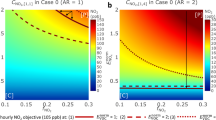Abstract
Linear programming is used to examine NOx as an air quality management problem. Through the use of transfer coefficients, which translate source emissions of NOx into receptor impacts, the model developed herein seeks to minimize the total cost of reducing emissions from 14 major Canadian point sources. It does this subject to the constraint that the wet deposition at 5 sensitive receptors must be reduced by at least some minimum amount. Several different reductions in wet deposition are used to observe the increase in costs associated with a systematic ‘tightening’ of the constraint relationships. A particular level of reduction is used to examine, on a more detailed level, the sources requiring some level of removal. These case study results and an analysis of the rationale for their solution are presented. Also presented is a comparison between this type of optimization strategy and the scenario of a single ‘across-the-board’ emissions cutback. From NOx considerations alone, it would seem more expedient to concentrate current research efforts into developing technologies to further reduce vehicle emissions, since their magnitude considerably outweighs those from the point sources.
Similar content being viewed by others
References
ACUREX Report: 1978,Summary of Combustion — Modifications: Nitrogen Oxide Controls, Emission Levels, Costs, and Fuel Impacts, TM-78-204.
Atkinson, S. E. and Lewis, D. H.: 1974,A Cost-Effectiveness Analysis of Alternative Air Quality Control Strategies, Journal of Environmental Economics and Management.
Clark, T. L.: 1980,Atmospheric Environment 14, 961.
Cyberware Computer Systems Ltd.: 1978,User's Manual for LP1, Computer Solutions for Linear Programming, Kitchener, Ontario.
Elliot, T. C. and Schwiegger, R. C.: 1984,The Acid Rain Sourcebook, McGraw-Hill, Inc., New York.
Ellis, J. R., McBean, E. A., and Farquhar, G. J.: 1985,ASCE-Journal of Environmental Engineering Division, III, p. 119.
Environment Canada: 1977–1978,Canadian Network for Sampling Precipitation (CANSAP) Data Summary, Atmospheric Environment Service, UDC: 55-578-8.
Fortin, M. and McBean, E. A.: 1983,Atmospheric Environment 17, 2331.
Galvin, P. J. and Cline, J. A.: 1978,Atmospheric Environment 12, 1163.
Horn, A. V., Arpi, D., Bowen, C., Chapman, R., and Cooper, R.: 1981,Electric Utility Emissions: Control Strategies and Costs, Teknekron Inc., Berkeley California, DOE/PE/70291-T1, April.
Lyon, R. K.: 1979,Environment Science Technology 11, 226.
McLean, R. A. N.: 1981,JAPCA 31, 1184.
Ontario Hydro: 1981, Acid Rain, Research Review Number 2, May.
Ontario Ministry of the Environment: 1981,The Province of Ontario: A Submission to the United States Environmental Protection Agency on Interstate Pollution Abatement, Docket No. A-81-09, December.
Ontario Ministry of the Environment (OME): 1983,Linear Programming Screening Model for Development and Evaluation of Acid Rain Abatement Strategies, Policy and Planning Branch, October.
Ontario Ministry of the Environment (OME): 1984,Acidic Precipitation in Ontario Study (APIOS): Annual Statistics of Concentration and Deposition — Cumulative Precipitation Monitoring Network 1982, ARB-110-84-ARSP, July.
Ontario Ministry of the Environment (OME): 1986, Personal Communications, Air Resources Branch, Toronto, Ontario.
Organisation for Economic Co-operation and Development (OECD): 1983,Control Technology for Nitrogen Oxide Emissions from Stationary Sources, Paris.
Schwing, R. C., Southworth, B. W., Von Buseck, C. A., and Jackson, C. J.: 1980, Benefit-Cost Analysis of Automotive Emission Reductions′,Journal of Environmental Economics and Management 7, 44.
Slinn, W. G. N.: 1982,Water, Air, and Soil Pollut. 18, 45.
Speedy-Muffler King: 1986, Personal Communications, Waterloo, Ontario.
U.S. - Canada: 1981,Memorandum of Intent on Transboundary Air Pollution: Emissions, Costs and Engineering Assessment (MOI), Interim Report, Work Group 3B, February.
United States Environmental Protection Agency (USEPA): 1978,Short-Term Nitrogen Dioxide Standards, Volume II:Estimated Cost of Meeting Alternative Standards, December.
United States Environmental Protection Agency (USEPA): 1980,Research Summary: Controlling Nitrogen Oxides, EPA-600/8 - 80-004, February.
Voldner, E. C., Shah, Y., and Whelpdale, D. M.: 1980,Atmospheric Environment 14, 925.
Walker, J. R.: 1975,Automobile Emission Control: Means and Cost, Discussion, Paper No. 41, Economic Council of Canada.
Yaverbaum, L. H.: 1979,Nitrogen Oxides Control and Removal: Recent Developments, Noyes Data Corporation, Pollution Technology Review No. 60.
Author information
Authors and Affiliations
Additional information
Author for all correspondence.
Rights and permissions
About this article
Cite this article
Wareham, D.G., McBean, E.A. & Byrne, J.M. Linear programming for abatement of nitrogen oxides acid rain deposition. Water Air Soil Pollut 40, 157–175 (1988). https://doi.org/10.1007/BF00279464
Received:
Revised:
Issue Date:
DOI: https://doi.org/10.1007/BF00279464




